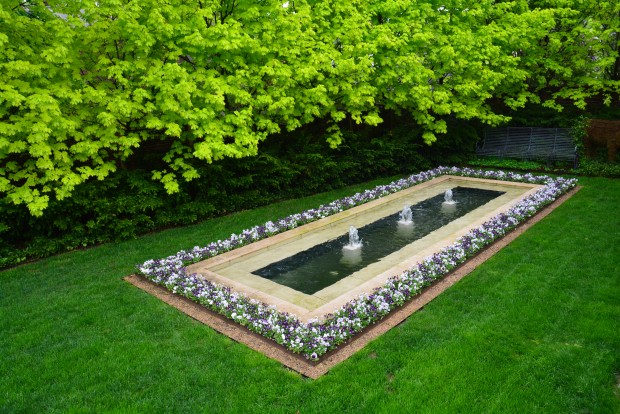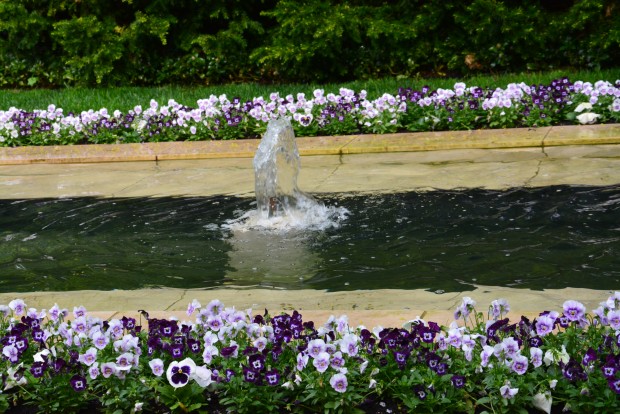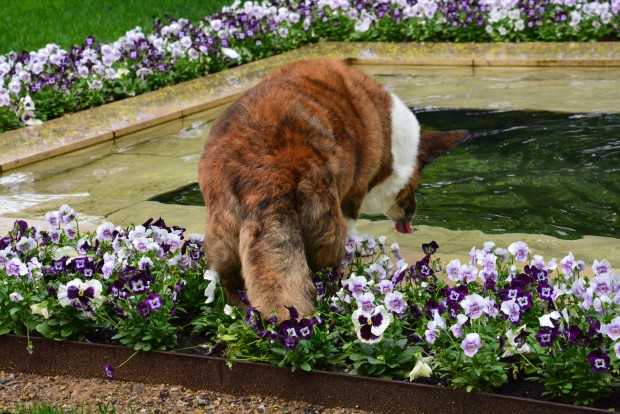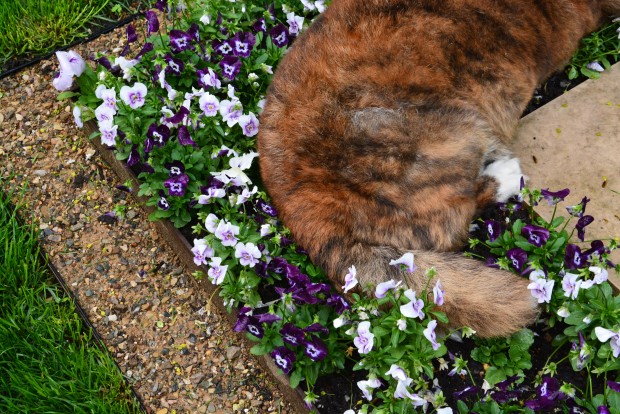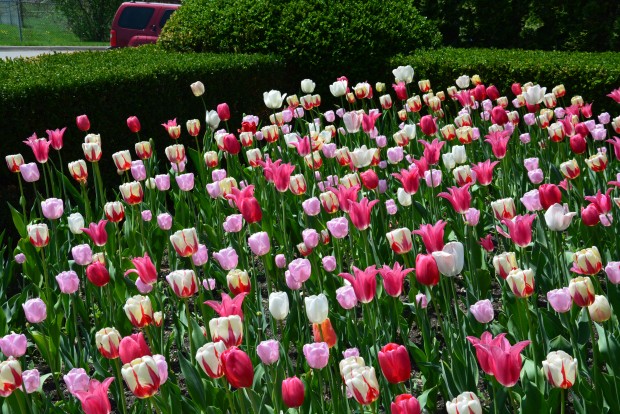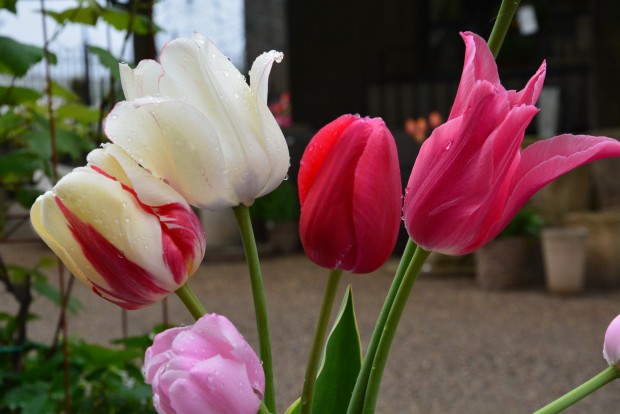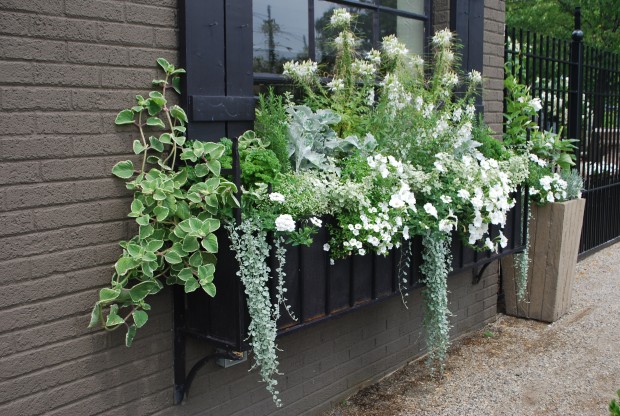 Despite a run of very warm weather, and the tomato plants I have seen sitting outdoors for sale, it is still very much the spring season here. One of my favorite things about gardening in the mid west is the fact that the seasons change. I like all of them. Spring is a special favorite, as it comes on the heels of the dregs of the winter. Speaking of the dregs, we have a forecast for 37 degrees overnight. Our last frost date is the end of May-some 2 weeks away. This is no hardship. The spring season, even on the coolest of days, is a delight. My variegated lily of the valley is proof positive of that. My tulips are on hold, in full bloom. The dogwoods are just about in full bloom, as are the lilacs.
Despite a run of very warm weather, and the tomato plants I have seen sitting outdoors for sale, it is still very much the spring season here. One of my favorite things about gardening in the mid west is the fact that the seasons change. I like all of them. Spring is a special favorite, as it comes on the heels of the dregs of the winter. Speaking of the dregs, we have a forecast for 37 degrees overnight. Our last frost date is the end of May-some 2 weeks away. This is no hardship. The spring season, even on the coolest of days, is a delight. My variegated lily of the valley is proof positive of that. My tulips are on hold, in full bloom. The dogwoods are just about in full bloom, as are the lilacs.
 The spring flowering trees are at their best when the spring is cool and moderate. Some years ago all of the flowers on my magnolias were frosted off, and the new shoots sustained damage as well. Our past winter was terrifically cold-especially in February. As a result, my magnolia flowers are so so this year. But I have seen lots of crab apples, cherries, red buds, and Bradford pears striking in bloom. The spring flowering trees-I would take a chance on them. My dogwoods are just beginning to bloom. Spring blooming trees are a marvel, and there are so many kinds to choose from. I see very few young flowering trees when I drive through neighborhoods. And not so many stands of tulips either.
The spring flowering trees are at their best when the spring is cool and moderate. Some years ago all of the flowers on my magnolias were frosted off, and the new shoots sustained damage as well. Our past winter was terrifically cold-especially in February. As a result, my magnolia flowers are so so this year. But I have seen lots of crab apples, cherries, red buds, and Bradford pears striking in bloom. The spring flowering trees-I would take a chance on them. My dogwoods are just beginning to bloom. Spring blooming trees are a marvel, and there are so many kinds to choose from. I see very few young flowering trees when I drive through neighborhoods. And not so many stands of tulips either.
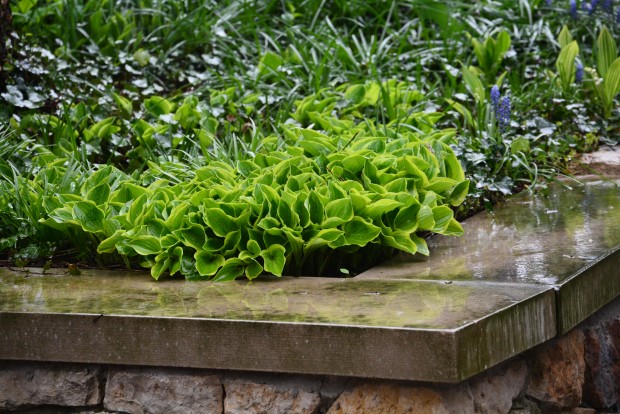 I ascribe this to the notion that many people feel the spring is especially ephemeral, and is shorter than the other seasons. However, the spring is just as long as every other season. The spring does not begin with a flowering phase. The long process by which plants emerge from the ground and break dormancy is every bit as beautiful as a patch of daffodils in bloom. That pale limey green I call spring green is as visually lush as the new growth.
I ascribe this to the notion that many people feel the spring is especially ephemeral, and is shorter than the other seasons. However, the spring is just as long as every other season. The spring does not begin with a flowering phase. The long process by which plants emerge from the ground and break dormancy is every bit as beautiful as a patch of daffodils in bloom. That pale limey green I call spring green is as visually lush as the new growth.
 These dwarf spruce are not so dwarf any more, after 30 years in the ground. When the new growth emerges on the tips of every branch in the spring, the visual effect is spectacular. The hellebores have been in bloom for at least a month. The warm weather pushed every plant full speed ahead. At times there was too much to look at, and not enough time to look. A good friend in the nursery business told me years ago that his gardens are designed to peak in late summer-this is when he has the time to appreciate them. I want it all. Every season. This is why I make a special effort to enjoy the spring, even though it is a very busy time of year.
These dwarf spruce are not so dwarf any more, after 30 years in the ground. When the new growth emerges on the tips of every branch in the spring, the visual effect is spectacular. The hellebores have been in bloom for at least a month. The warm weather pushed every plant full speed ahead. At times there was too much to look at, and not enough time to look. A good friend in the nursery business told me years ago that his gardens are designed to peak in late summer-this is when he has the time to appreciate them. I want it all. Every season. This is why I make a special effort to enjoy the spring, even though it is a very busy time of year.
 This patch of creeping jenny, campanula, and sweet woodriff is lush and fresh. That quality applies to every inch of the spring landscape. All of the failures in the garden now are winter failures. Everything in the spring garden is growing robustly. Regular rain sustains all that growing. There hasn’t been enough time for bugs and fungus to take hold. The time for disappointment comes much later. The spring is about promise and possibility.
This patch of creeping jenny, campanula, and sweet woodriff is lush and fresh. That quality applies to every inch of the spring landscape. All of the failures in the garden now are winter failures. Everything in the spring garden is growing robustly. Regular rain sustains all that growing. There hasn’t been enough time for bugs and fungus to take hold. The time for disappointment comes much later. The spring is about promise and possibility.
 My yellow magnolias are rarely in bloom longer than a week or 10 days, but each one those days is heavenly. I look forward to them with great anticipation. The spring garden has an expectant atmosphere. How ephemeral the flowering makes the experience of that blooming all that much more sweet.
My yellow magnolias are rarely in bloom longer than a week or 10 days, but each one those days is heavenly. I look forward to them with great anticipation. The spring garden has an expectant atmosphere. How ephemeral the flowering makes the experience of that blooming all that much more sweet.
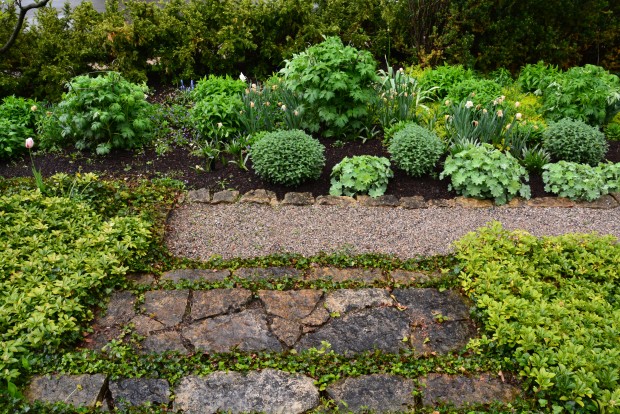 My perennial garden is finally beginning to fill in. The delphiniums should be so beautiful this year. They have just about filled the tomato cages that I hope will keep them aloft when they flower. Would that the catmint would keep this shape. By midsummer it will fall to the ground, splay out, and need shearing. This moment is a good one.
My perennial garden is finally beginning to fill in. The delphiniums should be so beautiful this year. They have just about filled the tomato cages that I hope will keep them aloft when they flower. Would that the catmint would keep this shape. By midsummer it will fall to the ground, splay out, and need shearing. This moment is a good one.
 Rob plants lots of spring pots, many of which feature lettuce, bok choy, chard, and herbs. This pot is good enough to eat. That luscious quality speaks to the best of what spring has to offer. There is no other fresh like spring fresh.
Rob plants lots of spring pots, many of which feature lettuce, bok choy, chard, and herbs. This pot is good enough to eat. That luscious quality speaks to the best of what spring has to offer. There is no other fresh like spring fresh.
 This new garden we did for a client last year has a few early flowering perennials-notably euphorbia polychroma and anemone sylvestris. My client planted yellow and white viridiflora tulips, and white triumph tulips. What a charming spring garden she has.
This new garden we did for a client last year has a few early flowering perennials-notably euphorbia polychroma and anemone sylvestris. My client planted yellow and white viridiflora tulips, and white triumph tulips. What a charming spring garden she has.
 I can hardly believe I have seen basil for sale outdoors already. It despises cold soil, as do tomatoes, and many of the summer season annuals. The best way to tell if you can plant for summer is to put your finger in the soil. If it is very cold, wait to plant any tropical plants. A week of consecutive night temperatures above 50 degrees is a sign you might consider planting tropical plants. I am not ready for geraniums, or calocasia, or caladiums. I want my spring as long as I can have it. The best way is to ignore the siren call to plant for summer when it is too early is to cultivate a spring garden, and enjoy the spring around you while it lasts.
I can hardly believe I have seen basil for sale outdoors already. It despises cold soil, as do tomatoes, and many of the summer season annuals. The best way to tell if you can plant for summer is to put your finger in the soil. If it is very cold, wait to plant any tropical plants. A week of consecutive night temperatures above 50 degrees is a sign you might consider planting tropical plants. I am not ready for geraniums, or calocasia, or caladiums. I want my spring as long as I can have it. The best way is to ignore the siren call to plant for summer when it is too early is to cultivate a spring garden, and enjoy the spring around you while it lasts.
